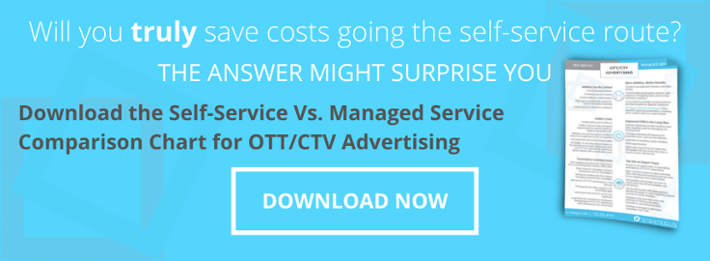- Home
- Strategus Blog
- How Automatic Content Recognition Helps Optimize Your Targeting
How Automatic Content Recognition Helps Optimize Your Targeting
 Andy Dixon
Andy Dixon
5 minutes read

As a marketing leader, you know the big picture goals for your marketing campaigns every quarter. But translating those goals into actionable strategies is more difficult, especially as you try to create more granular levels of insight and tasks.
Improving data-driven platforms and technologies can close the gap between the numbers you want to hit and the exact steps it takes to move your audience from viewers to leads to customers.
That's where ACR — or automatic content recognition — comes into play. ACR data is becoming a crucial tool for marketing teams. ACR gives marketers the data they need to eliminate the overlap between CTV and linear TV ad exposure, ultimately optimizing targeting efforts and creating a better experience for their target audience.
With clear, data-based connections between steps taken or expenses made and qualitative goals, it's easier to know when your strategies and individual projects are headed in the right direction. In this article, we'll explore what automatic content recognition is, how it works, and why it's so vital for online and OTT advertisers in 2021.
What is automatic content recognition (acr)?
At its core, automatic content recognition is a type of technology that can recognize snippets of media either played on a device or in a media file. This technology is embedded in set-top boxes and allows marketers to understand where their advertisements are being seen.
For example, an ACR-enabled system can see a viewer watching one type of media recommend suitable supplemental material for them to view — or just place it in a curated queue. Similarly, advertisers can use ACR to determine which ads best fit the viewer's current watching experience, who has viewed their ads, and what device they viewed them on.
how automatic content recognition works
ACR works across a wide variety of media platforms, such as CTV systems, linear cable television, and even video games. The technology works by comparing the small in-the-moment snippet to a vast library of properly cataloged data to find exactly what the snippet is. In greater detail:
- Media companies create a reference library of content. This is the archive of everything on television that future snippets will be compared to. Data centers catalog each moment, adding in all the metadata about when the media plays (on linear television), what video game, movie, or television show the snippet comes from, and any other useful information. Managing companies expend a lot of time and effort cleaning the data to create a refined, reliable library of listening posts.
- ACR pulls a snippet from a viewer's current media and compares it to the library.
- The content is matched with the right file full of metadata. These images or sound elements can happen once every 10 seconds or multiple times a second; as more snippets are compared in the library, the library continues to grow.
"To create the reference library, you need 'listening posts,'" explains Jane Clarke, CEO and managing director of CIMM. "Computers in data centers 'watch' TV and catalog what they see. Then, that reference library is matched against a schedule of what ran, so the computer can match the image and audio to a 9 p.m. prime-time episode, for example."
why acr is useful
Some of the benefits of ACR include:
- Dynamic ad insertion: Rather than having manually pre-established ad points on a program that interrupts every viewer at the same point in the program, ACR lets advertising platforms determine the best point for the ad based on the viewer's experience and past behavior.
- Better reach: ACR technologies allow smart marketing platforms to determine if viewers on an OTT/CTV system haven't viewed a program on linear television. Then they can expose the viewer to that linear television ad without risking ad fatigue or boredom.
- Omnichannel marketing: ACR lets advertisements flow more naturally across multiple devices that share the same IP address. Rather than starting one advertising path on a smart TV and restarting the same path on the same viewer's phone, the two devices work together for a more seamless experience.
acr and targetting optimization
how to optimize your targeting
Every organization must optimize who sees their ads and when they see them in order to create the best results. You want to be the first brand they think of when they're looking for a solution in your area of specialization. High-frequency advertising is a crucial component of brand amplification and lift, but it's not enough to just send frequent ads in the direction of your target market.
Instead, you need to ensure that your targeting efforts are optimized using ACR. This technology allows you to understand who is watching what and deliver your ads accordingly, ultimately leading to optimized reach and effective frequency.
Read more on advertising reach, frequency, and impact here
When you use ACR effectively, you can optimize targeting efforts by:
- Carefully balancing frequency against the risk of ad fatigue
- Delivering the right ads in a campaign to your individual audience members at the right time
- Exposing viewers to your ads across multiple different platforms in different contexts so you stay relevant and build more connections with their thoughts without being overwhelming
ACR and other AI technologies give you more insight into viewer behavior and exposure to your campaigns. You can understand:
1. how your target audience uses their cable or ott television services
You can fill in the details about your customers by learning when they view television through linear or streaming services, what programs they prefer, and their relevant behaviors during and after viewing.
Say a portion of your viewers tends to watch OTT programs during dinner; that might be the ideal time for certain ads rather than others, whereas your audience is more favorable towards other ads if they're viewing media before their morning commute.
This information lets you create and display ads that meet viewers based on their current needs and preferences.
2. how they've already been exposed to your ads
Just as importantly, ACR-enabled strategies let you create more curated experiences with your ads. You can track if a viewer was already exposed to an ad through linear TV so you know not to target them in an OTT campaign and instead feed them ads that move them through the buyer’s journey.
You can also track their overall exposure so they stay under the frequency cap for your campaign and don't risk ad fatigue.
benefits of acr data for optimized targeting
Ultimately, ACR data lets you learn more about your audience and how they interact both with your ads and the media that surrounds them. With that insight, you can create more pleasant audience experiences that guide viewers through the buyer's journey and the ad paths you've created for your current campaigns.
optimize your targeting with strategus
As you explore incorporating ACR into your OTT strategies, our experts at Strategus are here to help. We're leading providers of CTV/OTT advertising analytics services. Contact us today to learn more about how we can help you cut through the noise and create stronger impressions of your brand.

Andy Dixon is a seasoned Content Writing Specialist at Strategus, renowned for his expertise in creating engaging and impactful digital content. With over a decade of experience in content creation, Andy has honed his skills in a variety of niches, ranging from technology and marketing to education.
Strategus is a managed services connected TV(CTV) advertising agency with over 60,000+ campaigns delivered. Find out how our experts can extend your team and drive the result that matter most.
Talk to an Expert
Seeking a Custom CTV Strategy That Delivers?
What to read next

Third-Party Data Targeting for CTV: Benefits & Tactics
Third-party data. It’s a term that’s thrown around, and yet few take the time to detail its pros and cons — much less strategies for using...
7 minutes read

First-Party Data Targeting: Benefits and Tactics for CTV Advertising
First-party data is the information that companies collect directly from their customers rather than through intermediaries. Advertisers use this...
10 minutes read

Foot-Traffic Attribution: Tying Ad Impressions to In-Store Visits
The marketing funnel has changed. Today’s shoppers often begin researching products from the comfort of their homes and don’t set foot into a store...
8 minutes read

CTV Attribution: What It Is and How It Works
Connected TV (CTV) viewing is on the rise — and that’s good news for marketers. Not only can CTV ads be precisely targeted to individual households,...
9 minutes read


















